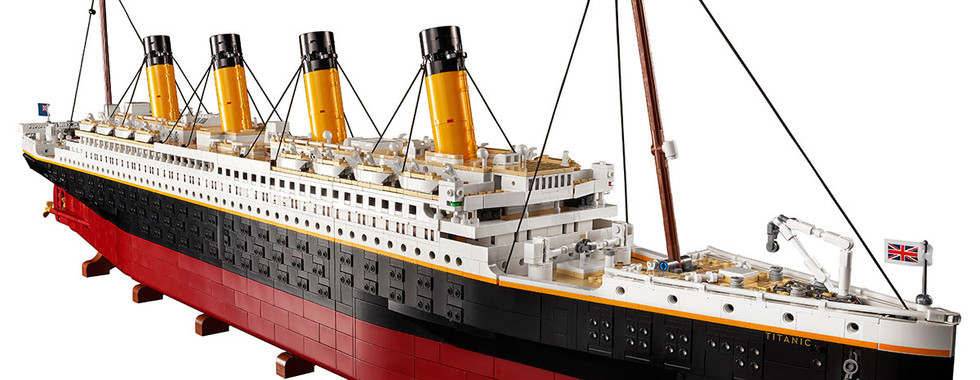The LEGO Titanic Set: A Masterpiece of Detail and Scale
Set number: 10294
Name: Titanic
Theme: Icons
Released: November 2021
Retired: TBD
Pieces: 9,090
Set Designer: Mike Psiaki
RRP: £589.99 / $679.99 / 679.99€
Price per piece: 6.5p / 7.5c / 7.5c
Age range: 18+
Packaging: Box
Dimensions: 58.5 x 47.5 x 38.5 cm
(23 x 18.7 x 15.2 in)
The LEGO Titanic set is a stunning and intricate LEGO creation, designed to capture the beauty and majesty of one of the most famous ships in history. The set is the work of the talented LEGO designer Rok Zgalin Kobe, who has created a true masterpiece of engineering and creativity, incorporating over 9,000 pieces and measuring over 3 feet long.
Design and Features
The LEGO Titanic set is an impressively detailed and accurate recreation of the famous ocean liner, with a remarkable level of attention paid to every aspect of the ship's design and features. Some of the notable design features and details of the LEGO Titanic set include:
The ship's four funnels, each of which is made up of dozens of individual LEGO pieces. These funnels are positioned at an angle, just as they were on the real Titanic.
The grand staircase, which is beautifully recreated with intricate details and ornate decorations. This staircase was one of the most iconic features of the real Titanic, and the LEGO version captures its elegance and beauty perfectly.
The lifeboats, which are positioned around the ship and can be easily removed and placed in the water. This feature adds an extra level of realism and interactivity to the set.
The ship's decks, which are made up of hundreds of individual LEGO tiles and plates, creating a realistic and textured surface. This attention to detail is evident throughout the set, from the ship's hull to its various rooms and compartments.
The ship's various rooms and compartments, which are recreated with impressive attention to detail, from the luxurious first-class cabins to the cramped quarters of the third-class passengers. The LEGO Titanic set also includes a number of minifigures, representing the ship's crew and passengers.
Specifications
The LEGO Titanic set is an impressive feat of LEGO engineering, incorporating over 9,000 pieces and measuring over 3 feet long. Here are some of the key specifications and details of the set:
Piece count: 9,090
Length: 53 inches (134 cm)
Width: 14 inches (36 cm)
Height: 9 inches (24 cm)
Weight: 14.5 pounds (6.6 kg)
The set is designed for advanced LEGO builders and collectors, and its impressive size and scale make it a truly awe-inspiring creation.
Facts and Trivia
In addition to its impressive design and features, the LEGO Titanic set is also packed with interesting facts and trivia about the real Titanic and its history. Here are just a few examples:
The real Titanic was launched on May 31, 1911, and completed its maiden voyage on April 10, 1912.
The ship was built by the Belfast-based shipbuilding company Harland and Wolff for the White Star Line, a British shipping company.
The Titanic was the largest ship of its time, measuring over 882 feet long and 92 feet wide.
The ship had a total of 20 lifeboats, but only enough to accommodate around half of its passengers and crew.
The Titanic struck an iceberg on the night of April 14, 1912, and sank just a few hours later, with the loss of over 1,500 lives.
The LEGO Titanic set was designed by Rok Zgalin Kobe, a talented LEGO designer who has also worked on a number of other iconic LEGO sets.
Conclusion
The LEGO Titanic set is an impressive and awe-inspiring LEGO creation, designed to capture the beauty and majesty of one of the most famous ships in history. With over 9,000 pieces and measuring over 3 feet long, the set is a true masterpiece of LEGO engineering and creativity, and a must-have addition to any LEGO collection or display. Designed by the talented Rok Zgalin Kobe, the LEGO Titanic set is an impressive recreation of the iconic ocean liner, capturing its beauty and majesty with remarkable accuracy and attention to detail.
Whether you're a LEGO enthusiast, a fan of the Titanic's rich history, or simply appreciate beautiful and impressive LEGO creations, the LEGO Titanic set is a true masterpiece, and a testament to the power of creativity and imagination. From the ship's four funnels to its grand staircase, and from its lifeboats to its various rooms and compartments, every aspect of the LEGO Titanic set is designed to impress and inspire, and to bring the history and majesty of the real Titanic to life in a truly unique and memorable way.
The Titanic: A Tale of Innovation and Tragedy

The Titanic is perhaps the most famous ship in history, a legendary vessel that has captured the imagination of people around the world for over a century. Built in the early 20th century as the ultimate luxury liner, the Titanic was meant to be the largest and most luxurious ship of its time, a floating palace that would transport its passengers across the Atlantic Ocean in unparalleled comfort and style.
Despite its grandeur and opulence, however, the Titanic was also a ship with a tragic fate. Just four days into its maiden voyage from Southampton to New York City in April 1912, the Titanic struck an iceberg and sank, taking over 1,500 lives with it and leaving an indelible mark on history.
Specifications and Features
Here are some key specifications and features of the Titanic:
Length: 882 feet 9 inches
Height: 175 feet
Total decks: 10
Passenger capacity: Over 2,200
Lifeboats: 20
Propulsion: Triple-screw steam engines and electric propulsion
Maximum speed: 23 knots (26.5 mph)
Innovations:
The Titanic was designed to be the ultimate luxury liner of its time, incorporating numerous technological innovations that set it apart from other ships of the era. Some of these innovations included:
Triple-screw steam engines: The Titanic was powered by three giant steam engines that were capable of generating over 46,000 horsepower. This made it one of the fastest and most powerful ships of its time.
Electric propulsion: In addition to its steam engines, the Titanic also had electric generators that powered its numerous electrical systems, including the elevators, lighting, and telegraph system.
Luxurious amenities: The Titanic was designed to be the epitome of luxury and comfort, with amenities like a swimming pool, Turkish bath, squash court, and even a dog kennel for first-class passengers.
Advanced safety features: Despite its tragic sinking, the Titanic was actually considered to be one of the safest ships of its time, incorporating features like watertight compartments and an advanced telegraph system for communication with other ships.

Design Flaws:
Despite its many innovations and advanced safety features, the Titanic also had several design flaws that contributed to its tragic sinking. Here are some of the most significant design flaws:
Insufficient lifeboats: Perhaps the most well-known design flaw of the Titanic was its lack of sufficient lifeboats. Despite being capable of carrying over 2,200 passengers and crew, the Titanic only had 20 lifeboats, enough to hold around 1,200 people. This was due to a combination of factors, including cost-cutting measures and the belief that the Titanic was "unsinkable".
Inferior materials: Another factor that contributed to the Titanic's sinking was the use of inferior materials in its construction. The ship's hull was made of steel that was brittle in cold temperatures, and the rivets holding the hull together were not up to the standards of the time. When the Titanic struck the iceberg, the impact caused the hull to buckle and tear, leading to the flooding that ultimately caused the ship to sink.
Poor visibility: On the night of the Titanic's sinking, the weather conditions were clear but the sea was full of icebergs. However, the crew did not have sufficient visibility to spot the iceberg in time to avoid it. This was due in part to the lack of binoculars for the lookouts and the fact that the Titanic was sailing too fast in dangerous waters.
Inadequate training: Finally, many of the crew members aboard the Titanic were not adequately trained to deal with emergency situations like the one they faced on the night of the sinking. This contributed to confusion and chaos during the evacuation process and may have led to additional loss of life.
Despite its tragic fate, the Titanic remains an enduring symbol of human innovation and the power of technological progress. However, its legacy also serves as a cautionary tale about the dangers of overconfidence and the importance of safety and caution in all areas of life.

Background of the Titanic
The Titanic was built by the Belfast-based shipbuilding company Harland and Wolff for the White Star Line, a British shipping company owned by J. Bruce Ismay and the American financier J.P. Morgan. The idea for the ship came about in the early 1900s, when Ismay and Morgan envisioned a new class of ocean liner that would be even larger and more luxurious than anything that had come before it.
Construction of the Titanic began in 1909, and it took three years to complete. The ship was launched in May 1911 and underwent extensive sea trials before making its maiden voyage from Southampton, England to New York City on April 10, 1912.
The Titanic was designed to be the largest and most luxurious ship of its time, with amenities and accommodations that were unprecedented in the world of ocean travel. Its opulent interiors included grand staircases, ornate dining rooms, and lavish cabins for first-class passengers, while its innovative features like the swimming pool, gymnasium, and Turkish bath were meant to set it apart from other ships of its era.
However, the Titanic's size and grandeur came with a high price tag, and its construction and operation were not without controversy. There were concerns about the cost-cutting measures that were used in the ship's construction, as well as the lack of lifeboats and other safety features that were required by maritime law at the time.
Despite these concerns, the Titanic set sail on its fateful voyage from Southampton on April 10, 1912. The ship made stops in France and Ireland before heading out into the open sea, but just four days into the journey, disaster struck.

The Sinking of the Titanic
On the night of April 14, the Titanic struck an iceberg in the North Atlantic, causing serious damage to the ship's hull and flooding several compartments. Despite efforts to stop the flooding and evacuate the ship, the Titanic sank in the early morning hours of April 15, with the loss of over 1,500 lives.
The sinking of the Titanic was a tragedy that shook the world and led to major reforms in maritime safety regulations. In the years that followed, numerous investigations were conducted into the causes of the disaster, and many theories were put forward about what went wrong and who was to blame.
Today, the Titanic remains one of the most iconic and fascinating ships in history, a symbol of both human innovation and hubris. Its legacy continues to inspire books, movies, and documentaries, and its tragic sinking serves as a reminder of the importance of safety and caution in the face of technological progress.
_edited.png)









Comments